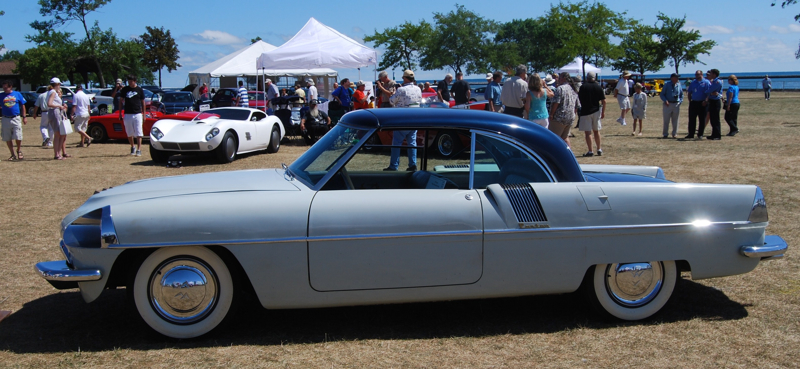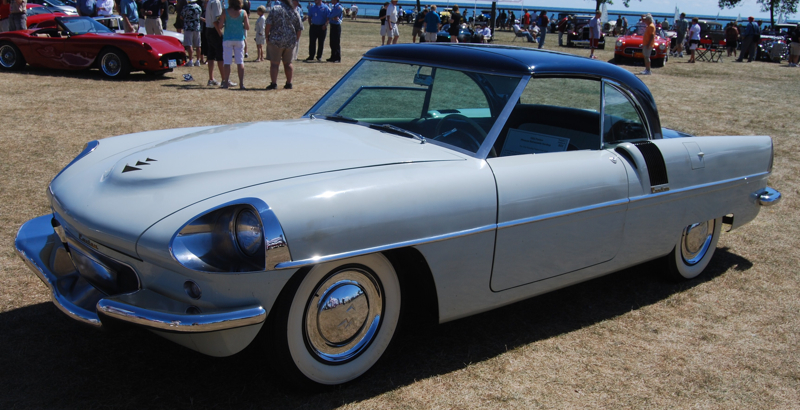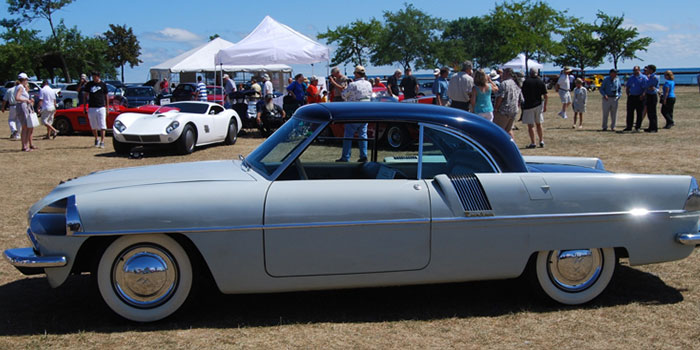Brooks Stevens, an industrial designer from Milwaukee, created the 1954 Paxton Phoenix, a rare prototype car now owned by collector Myron Vernis. The project took four years to complete and reportedly cost $1 million.
The Paxton Phoenix was the dream of Robert Paxton McCulloch, a man who founded McCulloch Motors Corp. and Paxton Superchargers. According to Myron Vernis, the car had 610 miles on the odometer when he bought it. He put about 10 miles on it in the first 10 years he owned it, but then put almost 120 miles on it during a Pebble Beach Road Tour. So it now has 735 original miles.

The Paxton features such innovations as an aircraft-type “torque box” frame and a retractable power-operated hardtop. Its fiberglass body was “leading edge” in the era when it was built. The Phoenix is equipped with power windows, power door locks, a leather interior, a padded dash and a full set of instruments. It includes an independent suspension and uses a dual-battery electrical system.
Robert McCulloch had a long time ambition to produce a true American luxury car and began thinking about the project in 1950 using a “clean sheet of paper” approach. He wanted to make a car that was like the chainsaws he manufactured — expensive, but successful because they were good!
Originally a smaller 115-in. wheelbase car was envisioned. The chassis design was jobbed out to Roscoe C. Hoffman, who had done a front-driver in the 1930s. Brooks Stevens Associates got the styling assignment and Paxton Div. started work on the mechanicals.
By late 1951, Stevens’ designers created a full-size clay model as well as a more finished plaster model. A rare midwestern earthquake occurred and the plaster model got cracked. However, the work went on and body molds were ready by August 1952. The Paxton was finally assembled in 1953. It was very advanced with its low overall height of 52 in. and a retractable hardtop.
The top was latched at the front like a cloth convertible top. When the latches were undone, small steel cables that were concealed in narrow slots along each side of the trunk lid pulled the top back over the rear deck through the action of an electric winch. If the top were the same color as the deck lid it would hardly be noticed sitting on top of it. So another color, a two-tone effect resulted.

Hoffman’s aircraft style “torque box” chassis worked and tested well. A unique 4-belt automatic transmission was developed. A two-cycle engine was originally envisioned. This soon morphed into a two-cycle three-cylinder engine with opposed pistons and two crankshafts. As the design evolved, the plans changed to four cylinders and eight pistons and the engine location was modified, too. Also considered were an air-cooled four and a 4-cycle V8. The idea of a six-cylinder compound-type steam engine was also experimented with.
Paxton only built the one car. It has a 118-in. wheelbase and was fitted with a 1953 Porsche Super four-cylinder engine. In 1954, for a variety of reasons, McCulloch Motors shelved the Paxton project and Robert McCulloch kept the car. In 1977, after McCullough died, his company held an auction of items in his private workshop and sold the car in it. Vasken Minasian was the high bidder. It wasn’t until 1992, after Minasian had passed away, that his sons Ari and Raffi cleaned the car up. They had the engine rebuilt by Steve Schmidtt of the Porsche 356 Registry. The body and suspension got attention from Paul Day and Vintage Racing Services, but the paint and upholstery were in top shape and left untouched. In 1993, the 610-mile car was shown for the first time.
Before his unexpected death on Jan. 4, 1995, Brooks Stevens purchased the Paxton car and brought it back to Milwaukee. It was the startling centerpiece for an exhibit of his work at the Milwaukee Design School. It was also kept at the Brooks Stevens Automotive Museum in Mequon, WI for a while. By 1998, Stevens’ museum closed and the cars were sold. Myron Vernis purchased the Paxton and has preserved it ever since.
(Editor’s Note: Brooks Stevens had this car in his museum listed as a 1954. However, the current owner might have done some research that makes it more logical to call it a 1953. This is the only one built. It has a Porsche engine, but it was not built by Porsche and is not a Porsche.)
Courtesy Speedville.



